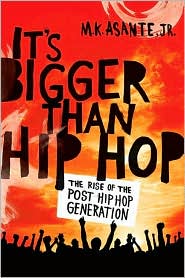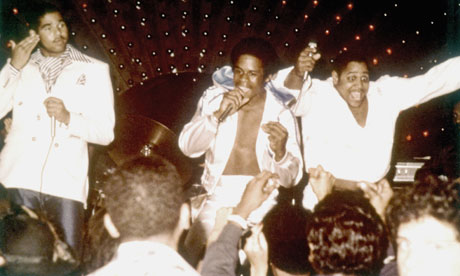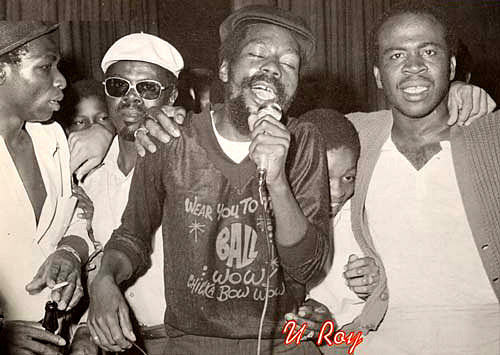People's Instinctive Travels Upon the Crossroads of Lack and Desire:
"Industrialized" Hip Hop in the Post Industrial Age
As always, using Simon Frith's "Technique and Technology" theory as our guide, we have learned through a combination of Cobb's To The Break of Dawn and Philipe Bougouis' In Search of Respect that Hip Hop music in the modern era is an amalgamation of the Blues ethos with South Bronx boom bap. By the early 90s, rap music became in particular characterized by the tragedy of urban America's crack cocaine epidemic, from its lyrical content to how it has been marketed by a global entertainment industry.
For an understanding of Hip Hop music in 2011, Rather than analyze record sales or identify who pioneered the seemingly infinite sub-genres of rap, we turn to Rha Goddess' essay "Scarcity and Exploitation: The Myth and Reality of the Struggling Hip Hop Artist." This essay along with Danny Hoch's "Toward a Hip Hop Aesthetic: A Manifesto for the Hip Hop Arts Movement" and, importantly, M.K. Asante Jr's chapter "Old White Men (Or, Who Owns Hip Hop?)" from It's Bigger Than Hip Hop provide for us a concluding analysis of where Hip Hop has come from, how it has grown and its present state. This is not a dissection which rapper is the "Greatest Of All Time" but are far more serious quest to identify Hip Hop's Collective Consciousness.
First, Rha Goddess defines Poverty Consciousness as psychological fear of lacking material items and denial of self worth. It is oft romanticized belief that this mental condition and material state is beneficial to artistic process. For example, while it is an oversimplification, we often correlate oppressive conditions with creative (African American) output. Think how we connect Jim Crow era oppression begetting the blues or urban strife in our America' northern cities creating the sound of jazz. Or the people in the South Bronx birthed Hip Hop culture in the face of post industrial peril. Simply put, right or wrong, we believe Poverty Consciousness breeds creativity.
Hip Hop culture did begin under the conditions of poverty and lack of resources. Danny Hoch calls them the “traditional aesthetics” of Hip Hop like the devices of metaphor or illusion. What has emerged as Hip Hop culture grew and its identity formed is a recognizable “Collective Consciousness.” (CC) Hip Hop's CC is its the understanding of identity, history, money, competition of survival, scarcity of resources, and feelings of exploitation (real or imagined).
Mobb Deep's "Hell On Earth" itemizes these real fears and imagines them to be something even worse:
Mobb Deep's "Hell On Earth" itemizes these real fears and imagines them to be something even worse:
Rap music is a defiant celebration of the struggle; going from rags to the riches, the transformation and triumph are hallmarks of the rap song form. Thus, rapper must "pay their dues" as a "starving artist" to establish credibility and validity. Game and 50 Cent make this clear in "Hate or Love It":
Rappers who obtain credibility and validity define themselves in lyrics, images or symbols as possessing or experiencing any or all of the following:
• In touch
• On the pulse
• Original
• Innovative
• Pioneering
• Crucifixion earns “extra props”
If an rap artist has not struggled to obtain this, they are “commercial” or “sellouts.” Paradoxically, credibility is diminished by success. (This was especially true during Hip Hop's Golden Era from1987 to 1993). What is the incentive to be anything else other than a "starving artist"? You must maintain the appearance of struggle even while succeeding.
A Tribe Called Quest “Check the Rhime"
But since the mid 1990s, making money off of Hip Hop has not only been accepted but it has all but become its singular focus. So why are rap artists today still "starving"? Answer: bad business practices.
Often in rap music (and perhaps other popular art forms), this "struggling" Collective Consciousness creates a trend of bad business management and poor business decisions.
Often in rap music (and perhaps other popular art forms), this "struggling" Collective Consciousness creates a trend of bad business management and poor business decisions.
Follow how a rapper's path to success takes shape in this narrative:
• Artist as victim. Faces lack of recognition, resources and stability.
• Organized money and institutions are the primary culprits along with fellow artists and unsupportive family and friends.
• Artists don't know how to do business and they are victims of labels, lawyers and finicky fans.
or conversely when a Hip Hop artist succeeds:
• Friends, family and community treat you differently
• Rappers feel uneasy and guilty about success
• Worse, they feel unsafe and about success (“watch your back”)
What develops is a “scarcity of success”; thus, the Hip Hop industry is:
What develops is a “scarcity of success”; thus, the Hip Hop industry is:
• fiercely competitive
• artists hoard information and work in isolation
• record labels marketing "gimmicks" are actual lived experiences. This ensures a rapper's authenticity and artistic dominance
Consider how the following "real life" situations are exploited by labels, media and / or the artist themselves. For rappers especially, the line between "real life" and entertainment is blurred purposely. This is nothing new to Hip Hop (or pop music) as the public criminal lives of Buskwick Bill, Slick Rick and Tupac all fueled record marketing strategies.
*Artist / Marketed Struggles and Events*
- Eminem / White, Addiction, Kim, Haley, Mom
- 50 Cent / Shot nine times
- Kanye / Car accident, Mom died, dumped by girlfriend
- Jay Z / Life of poverty, jail record, death of Auto-Tune
- Lil' Wayne / Pending charges, conviction, jail time
- Diddy / Biggie's death
Consider how the following "real life" situations are exploited by labels, media and / or the artist themselves. For rappers especially, the line between "real life" and entertainment is blurred purposely. This is nothing new to Hip Hop (or pop music) as the public criminal lives of Buskwick Bill, Slick Rick and Tupac all fueled record marketing strategies.
*Artist / Marketed Struggles and Events*
- Eminem / White, Addiction, Kim, Haley, Mom
- 50 Cent / Shot nine times
- Kanye / Car accident, Mom died, dumped by girlfriend
- Jay Z / Life of poverty, jail record, death of Auto-Tune
- Lil' Wayne / Pending charges, conviction, jail time
- Diddy / Biggie's death
“If skills sold, truth be told, I'd probably be / lyrically, Talib Kweli / Truthfully I wanna rhyme like Common Sense / But I did five mill' - I ain't been rhymin like Common since” - Jay Z “Moment of Clarity"
If an artist commits to having credibility they accept being under acknowledged and under paid because society doesn't “value” art with integrity.
“Hustlers and boosters embrace me and the music I be makin / I dumbed down for my audience to double my dollars / They criticized me for it yet they all yell "HOLLA!" - Jay Z “Moment of Clarity"
But art is valued in our society- We consume it in abundance, don't we? It is predominately thought of as escapism- it is supposed to be entertaining, amusing, easy to digest, not requiring much thought. Thus, rappers who choose artistic success often adopt these “dumbed down” strategies. Jay-Z takes a second to dis those who "dumb down" their "art" which ironically confirms his authenticity as a "true artist."
Hip Hop's "Industrial Era"
This Hip Hop Consciousness does not empower rappers and producers as their "artistic" practice is consumed by the machine of the music business. A sampling of the forms of companies, services and careers the Hip Hop and Rap Music Industry is comprised of:
• Entities that seek to profit from the marketing and sales of rap music and its ancillary products.
This Hip Hop Consciousness does not empower rappers and producers as their "artistic" practice is consumed by the machine of the music business. A sampling of the forms of companies, services and careers the Hip Hop and Rap Music Industry is comprised of:
• Entities that seek to profit from the marketing and sales of rap music and its ancillary products.
• Record companies
• Music publishers
• Radio stations
• Record Stores
• Music video shows/channels
• Recording Studios (Owners, Engineers, Mixers)
• Performance Venues
• Booking Agents
• Promoters
• Managers, Accountants, Lawyers
• Disc Jockeys
• Music Publications
• Music/Entertainment Websites
The state of the Hip Hop Industry largely parallels the economic inequality African Americans face at in society at large. With the synergistic relationship Hip Hop and R&B have had in the last 15 years, these “black” genre labels have re-categorized under the euphemism of “Urban Music” to make marketing of this product more palatable for "mainstream" tastes. But the following questions must be clearly answered if we are to think that Hip Hop music is something more than disposable entertainment:
Who sponsors rap?
Who buys the most rap?
Who promotes death and violence?
Who backs ignorance?
Who exploits Hip Hop artists?
Who profits from “Black on Black” violence?
Who owns “urban” radio stations, television stations, print publications?
Mos Def's "freestyle" cut "The Rape Over" asks the same:
To quote Jay Z, truth be told, major label rappers have little to no ownership in this distribution, marketing and ultimate profit from their product. The “Big Four” Universal Music Group, Sony BMG, EMI Group, Warner Music Group account for 82% of US Music Market and 90% of the retail market. There are no Black Americans in the top executive positions of these companies. Rap record labels and “black entrepreneurs” like Diddy, Russell Simmons, Jay Z give an illusion that the Hip Hop industry is "black owned" but the Big Four are really “parent” companies of the most prolific Hip Hop success stories. Diddy, Simmons and others employ “perception management” to create the illusion of control over the content of the music. Ultimately, these entrepreneurs make more money from clothing, liquor sales, car parts, etc. and other accessories than they do from music.
“Subliminal hypnotism and colonialism / leaves most niggaz dead or in prison”- Jeru da Damaja “Return of the Crooklyn Dodgers”
Neo-colonialism: Forcing countries to consume what they do not produce and produce what they do not consume. If the largest records and ancillary companies had but even a peripheral interest in the poor and the Black and Latino population rap music supposedly represents, then why would this rap "culture" be so overwhelming negative and self destructive?
Perhaps main stream rap's biggest audience is not even Black at all: According to Asante's referenced Forbes study: 45 million Hip Hop consumers between the ages of 13 and 34. 80% are White and have $1 trillion in spending power.
Perhaps main stream rap's biggest audience is not even Black at all: According to Asante's referenced Forbes study: 45 million Hip Hop consumers between the ages of 13 and 34. 80% are White and have $1 trillion in spending power.
Thus, “Commercial” Hip Hop is programmed by corporations that have little to no Black or ethnic representation despite peddling a product that purports to be “Black.” As a result the music:
• Has lost its edge
• Sense of rebellion and Black improvement
• The founding principals of artistry and empowerment
After the platinum successes of the low budget investments artists of the Golden Era, signed artists whose political agenda was in direct conflict with a record label's bottom line were dropped. The “Cop Killer” controversy accelerated this trend; the 2 Live Crew First Amendment “victory” certified that misogyny and Black on Black violence was a selling point.
A trend of “corporate censorship” has developed where politically charged artists are marginalized by the label's “choice” on how to distribute the product.
Restriction of socio-poltical Hip Hop artistry can take the form of:
• Intimidation
• Budget Cutting
• Refusing to advertise or allow airtime
• Dropping “questionable” songs from final product
• Repackaging of artwork
Large record labels are practicing a policy of that seeks to make money off Hip Hop art and culture as long as it does not challenge the status quo in tone or content.
Plain and simple, Hip Hop artists do not own their music because they do not own the channels of production. Ownership of the music, distribution of the music and the final manufactured product are largely beyond a Hip Hop artist's control. Thus, the feeling of alienation is sustained in Hip Hop's collective consciousness.
The widespread dysfunctional reaction of rappers to seemingly all forms of marginalization is a dominate Hip Hop musical narrative that outlines mass consumption of material items, drugs, guns and women as some sort of defiant stance. There is no spiritual base or sense of peace or accomplishment as the Hip Hop artist is seeking internal serenity but only acquires external satisfaction.
Hip Hop music at it best is "Edutainment," food for thought over sublime beats. But its capacity to subvert norms and revolution communication and pop cultural expression so readily realized in the 1970s, 80s and 90s have been stunted. Hip Hop "artists" and its audience may one day desire more than material success and it express themselves accordingly. But likely, we won't call it Hip Hop anymore.

























